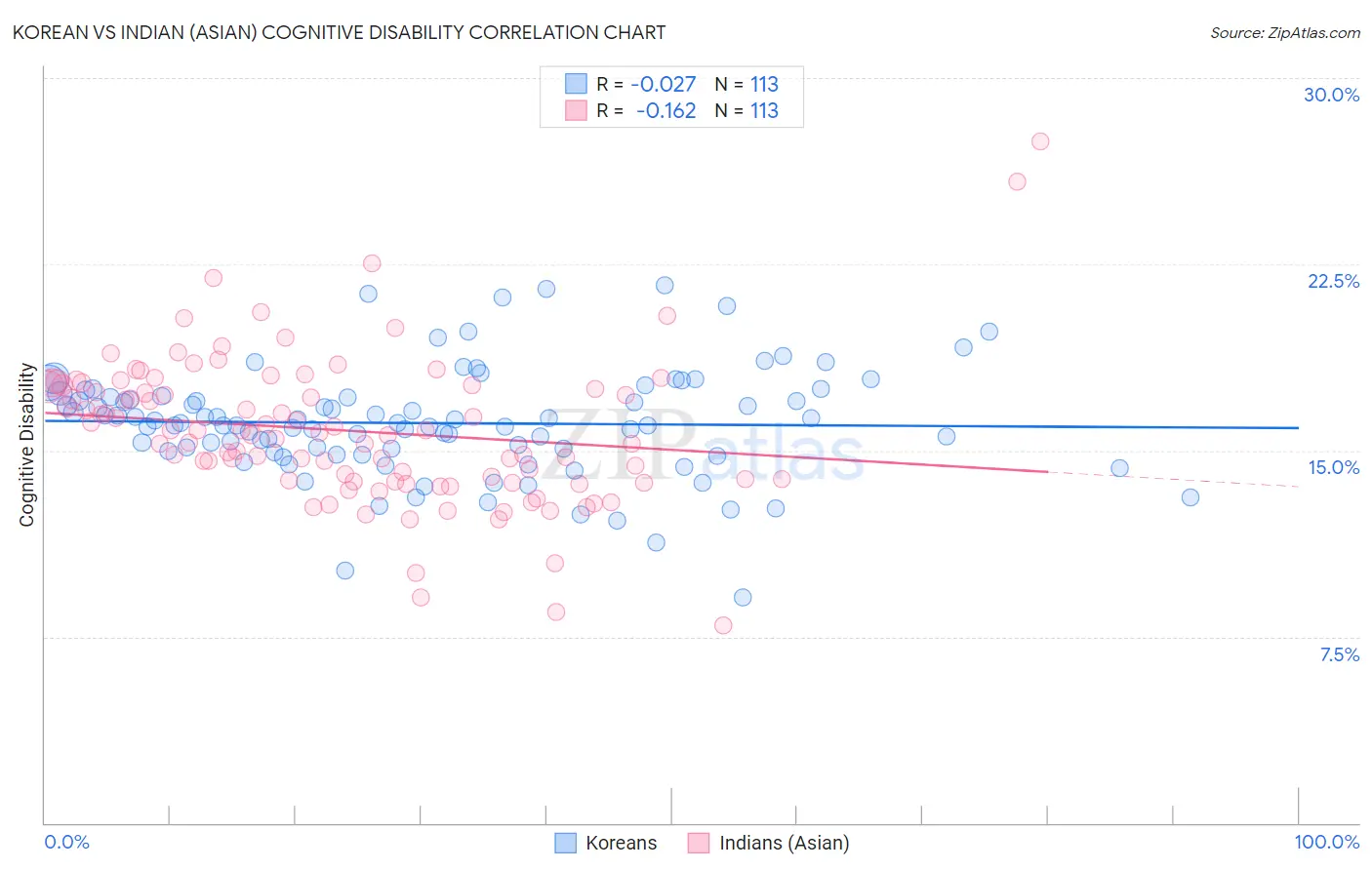Korean vs Indian (Asian) Cognitive Disability
COMPARE
Korean
Indian (Asian)
Cognitive Disability
Cognitive Disability Comparison
Koreans
Indians (Asian)
16.8%
COGNITIVE DISABILITY
97.1/ 100
METRIC RATING
114th/ 347
METRIC RANK
16.8%
COGNITIVE DISABILITY
97.2/ 100
METRIC RATING
112th/ 347
METRIC RANK
Korean vs Indian (Asian) Cognitive Disability Correlation Chart
The statistical analysis conducted on geographies consisting of 510,841,440 people shows no correlation between the proportion of Koreans and percentage of population with cognitive disability in the United States with a correlation coefficient (R) of -0.027 and weighted average of 16.8%. Similarly, the statistical analysis conducted on geographies consisting of 495,263,567 people shows a poor negative correlation between the proportion of Indians (Asian) and percentage of population with cognitive disability in the United States with a correlation coefficient (R) of -0.162 and weighted average of 16.8%, a difference of 0.010%.

Cognitive Disability Correlation Summary
| Measurement | Korean | Indian (Asian) |
| Minimum | 9.1% | 8.0% |
| Maximum | 21.7% | 27.5% |
| Range | 12.6% | 19.5% |
| Mean | 16.1% | 15.8% |
| Median | 16.1% | 15.7% |
| Interquartile 25% (IQ1) | 15.0% | 13.8% |
| Interquartile 75% (IQ3) | 17.2% | 17.6% |
| Interquartile Range (IQR) | 2.2% | 3.8% |
| Standard Deviation (Sample) | 2.2% | 3.0% |
| Standard Deviation (Population) | 2.2% | 3.0% |
Demographics Similar to Koreans and Indians (Asian) by Cognitive Disability
In terms of cognitive disability, the demographic groups most similar to Koreans are Immigrants from Sri Lanka (16.8%, a difference of 0.0%), Uruguayan (16.8%, a difference of 0.030%), Arapaho (16.8%, a difference of 0.040%), Albanian (16.8%, a difference of 0.050%), and Yup'ik (16.9%, a difference of 0.050%). Similarly, the demographic groups most similar to Indians (Asian) are Immigrants from Sri Lanka (16.8%, a difference of 0.0%), Uruguayan (16.8%, a difference of 0.020%), Albanian (16.8%, a difference of 0.040%), Arapaho (16.8%, a difference of 0.040%), and Yup'ik (16.9%, a difference of 0.060%).
| Demographics | Rating | Rank | Cognitive Disability |
| Paraguayans | 98.0 /100 | #103 | Exceptional 16.8% |
| Palestinians | 98.0 /100 | #104 | Exceptional 16.8% |
| Immigrants | Eastern Asia | 97.9 /100 | #105 | Exceptional 16.8% |
| Northern Europeans | 97.8 /100 | #106 | Exceptional 16.8% |
| Immigrants | Nicaragua | 97.8 /100 | #107 | Exceptional 16.8% |
| Canadians | 97.5 /100 | #108 | Exceptional 16.8% |
| Albanians | 97.3 /100 | #109 | Exceptional 16.8% |
| Arapaho | 97.3 /100 | #110 | Exceptional 16.8% |
| Uruguayans | 97.2 /100 | #111 | Exceptional 16.8% |
| Indians (Asian) | 97.2 /100 | #112 | Exceptional 16.8% |
| Immigrants | Sri Lanka | 97.1 /100 | #113 | Exceptional 16.8% |
| Koreans | 97.1 /100 | #114 | Exceptional 16.8% |
| Yup'ik | 96.9 /100 | #115 | Exceptional 16.9% |
| Inupiat | 96.5 /100 | #116 | Exceptional 16.9% |
| Immigrants | Japan | 96.2 /100 | #117 | Exceptional 16.9% |
| Immigrants | Denmark | 96.2 /100 | #118 | Exceptional 16.9% |
| South Africans | 95.5 /100 | #119 | Exceptional 16.9% |
| Scottish | 95.0 /100 | #120 | Exceptional 16.9% |
| Immigrants | China | 94.9 /100 | #121 | Exceptional 16.9% |
| Immigrants | Western Europe | 94.8 /100 | #122 | Exceptional 16.9% |
| Portuguese | 94.7 /100 | #123 | Exceptional 16.9% |